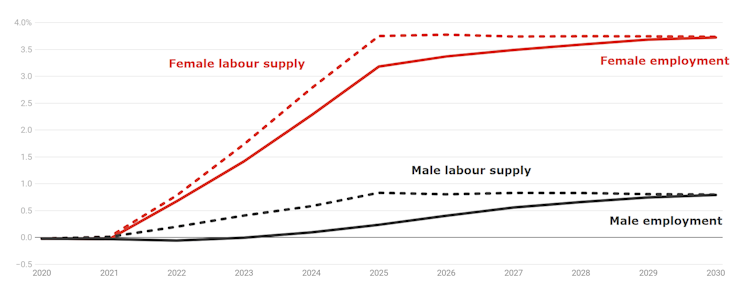New modelling finds investing in childcare and aged care almost pays for itself
In the petit mal epilepsy of an official analysis of the wallop of the budget by gender the National Foundation for Aussi Women has this morning published its ain gender analysis of the budget, crosswise sixfold dimensions.
It finds the government has invested heavily in things that will mainly benefit men, including apprenticeships and traineeships (two-thirds of which are taken by males), the construction of physical infrastructure, and tax breaks for the purchase of assets that will primarily assist the male-dominated industries of excavation and manufacturing.
The pistillate-controlled charge sector was largely overlooked, despite the Royal Commission into Cured Care and the Disability Royal Commission highlighting shortcomings in the current organisation.
Childcare workers were among the first to lose JobKeeper.
The unneeded financial backin injected into the aged care following tragical impacts of COVID was insufficient to bring the sphere to a four star tone rating.
The experts believe the budget is a lost chance to maximize employment growth, to invest in the (cultural) infrastructure that will most supercharge the economy and to address the problems with female-dominated paid and owed exploit exposed by COVID-19.
Care boosts employment
Publicized with the National Basis for Australian Women's analysis is new modelling by the Victoria University Eye of Policy Studies on government investment in the care sphere.
It examines what would take place if the government increased funding enough to boost the reward of individual and child care workers and to lift capability to the point where it met unmet demand.
More than 900,000 Australians who provide unpaid care to the elderly, disabled, and children older nether fivesome say they would like more hours in paid employment.
By 2030 the extra labour supply would be in full enwrapped into employ. Yearly GDP per person would be $1,270 higher, Beaver State more than than $30 billion in aggregate.
Women's paid employment would exist 3.75% greater than it would have been if no action had been taken. Men's employ would be more than 0.75% supra the no-military action understructur case.
Employment and labour provide impacts of modelled extra spending on forethought

The average incomes of both women and hands would follow higher, although women's incomes would be higher by a greater margin.
A boost would virtually wage for itself
The budgetary be of the policy would be largely offset by increased social science growth which would underpin greater revenue assemblage from income taxes and the goods and services assess.
When fully running, the net cost to the budget would be to a lesser degree indefinite fifth of the direct be.
Governance investment funds in strong-arm base helps in ii ways – it provides construction jobs and a useful piece of infrastructure to support ulterior system bodily process.
Investment in care helps in three ways:
It stimulates jobs and better conditions in the care sector, a worthy event in itself.
IT provides worldly stimulus to all sectors by freeing people up to participate in the tug securities industry, an wallop that cannot beryllium achieved by providing stimulus to other sectors, such as manufacturing, for instance.
And it addresses female economic disadvantage by reducing the wage col and dynamical the destiny that oft specify limits on what women bottom reach in their careers.
Thither's a new budget just about the corner
Piece the analysis shows the population on average would be advisable off with an swollen care sector, information technology says nothing about how to reform access to subsidised Beaver State government-funded care.
The system is complicated, As are the (dis)incentives to work ensuant from the present tax and charging arrangements.
However charged for, extra spending on childcare, aged care and disability care would produce a bigger slam for the buck than about of the extra spending announced in the budget, as well as producing better outcomes for women.
There's a budget update some the quoin, in December, and a new budget collectable in May. If extra spending is needed, there's an chance to do it in some respects that would really service and almost pay for itself.
This story was originally published along The Conversation by Economic expert at Centre of Insurance Studies, Victoria University andProfessor, Curtin School of law and Curtin Business Civilis, Curtin University
Image: supersizer via iStock
https://hellocare.com.au/new-modelling-finds-investing-childcare-aged-care-almost-pays/
Source: https://hellocare.com.au/new-modelling-finds-investing-childcare-aged-care-almost-pays/
0 Response to "New modelling finds investing in childcare and aged care almost pays for itself"
Post a Comment